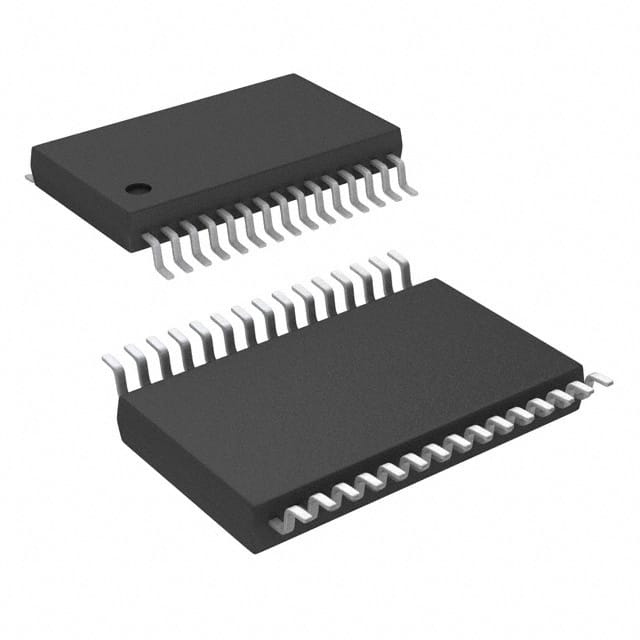Xem thông số kỹ thuật để biết chi tiết sản phẩm.

ADS7951SBDBT
Product Overview
- Category: Analog-to-Digital Converter (ADC)
- Use: Converts analog signals into digital data for processing and analysis
- Characteristics:
- High resolution and accuracy
- Low power consumption
- Wide input voltage range
- Fast conversion speed
- Package: Small Outline Package (SOIC)
- Essence: Provides precise and efficient analog-to-digital conversion
- Packaging/Quantity: Available in reels of 250 units
Specifications
- Resolution: 12 bits
- Input Voltage Range: 0V to Vref
- Conversion Time: 1.6 µs
- Power Supply Voltage: 2.7V to 5.5V
- Operating Temperature Range: -40°C to +125°C
- Interface: Serial Peripheral Interface (SPI)
Pin Configuration
The ADS7951SBDBT has a total of 16 pins, which are assigned as follows:
- VDD: Power supply voltage
- GND: Ground reference
- DIN: Serial data input
- DOUT: Serial data output
- SCLK: Serial clock input
- CS: Chip select input
- REF: Reference voltage input
- AGND: Analog ground reference
- AIN0: Analog input channel 0
- AIN1: Analog input channel 1
- AIN2: Analog input channel 2
- AIN3: Analog input channel 3
- AIN4: Analog input channel 4
- AIN5: Analog input channel 5
- AIN6: Analog input channel 6
- AIN7: Analog input channel 7
Functional Features
- High-resolution ADC with 12-bit output
- Supports differential and single-ended input modes
- Low power consumption for energy-efficient applications
- Fast conversion time enables real-time data acquisition
- Wide input voltage range allows for versatile signal processing
Advantages and Disadvantages
Advantages: - High resolution and accuracy ensure precise data conversion - Low power consumption extends battery life in portable devices - Wide input voltage range accommodates various signal levels - Fast conversion speed enables real-time applications
Disadvantages: - Limited number of analog input channels (8 in total) - Requires an external reference voltage for accurate conversion
Working Principles
The ADS7951SBDBT operates by sampling the analog input voltage and converting it into a digital representation using its internal ADC circuitry. The analog signal is first conditioned and amplified before being fed into the ADC. The ADC then quantizes the analog signal into a 12-bit digital value, which can be read through the serial interface.
Detailed Application Field Plans
The ADS7951SBDBT is widely used in various applications that require high-resolution analog-to-digital conversion. Some of the common application fields include:
- Industrial Automation: Used for monitoring and control systems in manufacturing processes.
- Medical Instruments: Enables precise measurement and analysis of biological signals.
- Test and Measurement Equipment: Provides accurate data acquisition for scientific experiments.
- Communication Systems: Used in wireless communication devices for signal processing.
- Automotive Electronics: Enables sensor data acquisition and control in automotive systems.
Alternative Models
Here are some alternative models that offer similar functionality to the ADS7951SBDBT:
- ADS7950: 10-bit resolution ADC with similar features and package.
- ADS7949: 14-bit resolution ADC with higher accuracy and slower conversion speed.
- ADS7924: 12-bit resolution ADC with lower power consumption and smaller package size.
These alternative models can be considered based on specific application requirements and trade-offs between resolution, accuracy, and other features.
Word count: 420 words
Liệt kê 10 câu hỏi và câu trả lời thường gặp liên quan đến ứng dụng ADS7951SBDBT trong giải pháp kỹ thuật
Sure! Here are 10 common questions and answers related to the application of ADS7951SBDBT:
Q1: What is the ADS7951SBDBT? A1: The ADS7951SBDBT is a 12-bit, 8-channel analog-to-digital converter (ADC) with a serial interface. It is commonly used in technical solutions for converting analog signals into digital data.
Q2: What is the supply voltage range for the ADS7951SBDBT? A2: The ADS7951SBDBT operates with a supply voltage range of 2.7V to 5.25V.
Q3: How many analog input channels does the ADS7951SBDBT have? A3: The ADS7951SBDBT has 8 analog input channels, allowing you to measure up to 8 different analog signals simultaneously.
Q4: What is the resolution of the ADS7951SBDBT? A4: The ADS7951SBDBT has a resolution of 12 bits, which means it can provide digital output values ranging from 0 to 4095.
Q5: What is the maximum sampling rate of the ADS7951SBDBT? A5: The ADS7951SBDBT has a maximum sampling rate of 1 MSPS (Mega Samples Per Second).
Q6: Does the ADS7951SBDBT support differential inputs? A6: Yes, the ADS7951SBDBT supports both single-ended and differential inputs, providing flexibility in measuring various types of analog signals.
Q7: Can I use the ADS7951SBDBT in low-power applications? A7: Yes, the ADS7951SBDBT features a power-down mode that allows you to minimize power consumption when the ADC is not actively converting analog signals.
Q8: What is the interface used to communicate with the ADS7951SBDBT? A8: The ADS7951SBDBT uses a serial interface called SPI (Serial Peripheral Interface) for communication with microcontrollers or other digital devices.
Q9: Does the ADS7951SBDBT have built-in reference voltage options? A9: Yes, the ADS7951SBDBT provides both internal and external reference voltage options, allowing you to choose the most suitable reference voltage for your application.
Q10: Can I cascade multiple ADS7951SBDBT ADCs together? A10: Yes, the ADS7951SBDBT supports daisy-chaining, which means you can connect multiple ADCs in series to expand the number of analog input channels in your system.
Please note that these answers are general and may vary depending on the specific requirements and configurations of your technical solution.

